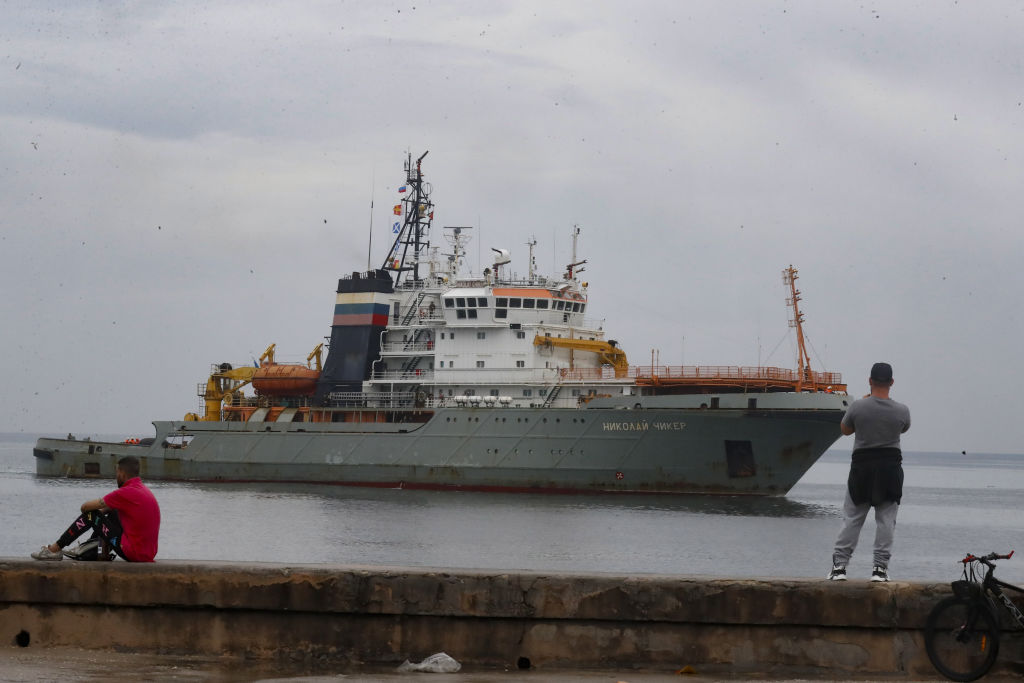Shades of the Cold War are ongoing just 90 miles from the US coast. On Wednesday, June 12, a flotilla of Russian warships converged on Havana, Cuba, to great celebratory activities. The port visit to America’s communist southern neighbor is part of a planned naval exercise in the waters of the Caribbean between June 12 and June 17. What makes the Russian stop in Cuba noteworthy to America, though, is the timing.
Russian Naval Task Group Makes Cuba a Port of Call
Tensions between the US and its adversaries, including Russia, are growing. Russia’s President Vladimir Putin has gone so far as to threaten America’s ally, Great Britain, with a nuclear attack. Otherwise, this port visit would be just another stop at one of Russia’s allies. However, geopolitical events transform the ordinary into a Kremlin activity that requires more attention and concern. It’s not surprising that Moscow would want to make a big splash in the waters close to the US since Putin no doubt takes exception to America and its NATO allies having routine training exercises in the maritime regions of northern Europe.
While on its way to Cuba, the Russian naval contingent conducted simulated missile attacks on opposing sea forces. As the Associated Press explained, the training was:
“…part of Moscow’s efforts to project power amid the tensions with the West over Ukraine. The Russian Defense Ministry said the Admiral Gorshkov frigate and the Kazan nuclear-powered submarine conducted the exercise that was intended to simulate a missile strike on a group of enemy ships. The ministry said the drills involved computer simulation of an attack on sea targets more than 600 kilometers (over 320 nautical miles) away.”
 When asked about the Russian naval force heading to Cuba during a Pentagon press briefing on Wednesday, June 12, Deputy Pentagon Press Secretary Sabrina Singh did not reflect any particular concern on the part of the Department of Defense. “We’ve been tracking the Russians’ plans for this. This is not a surprise. We’ve seen them do this – these types of port calls before, and these are, you know, routine naval visits that we’ve seen under different administrations,” she said. For example, according to reports, the Russian Navy Project 887 training ship Perekop visited the port of Havana in July 2023. Singh explained that the US routinely observes foreign military vessels near US territorial waters.
When asked about the Russian naval force heading to Cuba during a Pentagon press briefing on Wednesday, June 12, Deputy Pentagon Press Secretary Sabrina Singh did not reflect any particular concern on the part of the Department of Defense. “We’ve been tracking the Russians’ plans for this. This is not a surprise. We’ve seen them do this – these types of port calls before, and these are, you know, routine naval visits that we’ve seen under different administrations,” she said. For example, according to reports, the Russian Navy Project 887 training ship Perekop visited the port of Havana in July 2023. Singh explained that the US routinely observes foreign military vessels near US territorial waters.
“The group was operating just east of the Florida Keys as of Tuesday afternoon and is under surveillance by at least three US guided-missile destroyers and a P-8A Poseidon [US Navy version of the Boeing 737 airliner] anti-submarine aircraft,” USNI News reported. What got the US Navy’s attention was that the Russian ships included in the action group were the Kazan, a Yasen-M-class nuclear-powered guided missile submarine, and the Admiral Gorshkov, a modern guided-missile frigate believed to carry hypersonic missiles. Also making up the Russian four-vessel task group is the Nikolai Chiker, a heavy ocean-going tug, and the Project 23130 Academic Pashin, a replenishment oiler.
US and Canadian Navies Shadow Russian Warships
As part of the monitoring, the deputy press secretary mentioned that the US Navy and Canadian naval had been shadowing the Russian vessels. Two US destroyers, the USS Truxtun and USS Donald Cook, along with the US Coast Guard cutter USCGC Stone and a Royal Canadian Navy frigate, the HMCS Ville de Québec, have been sailing close behind the Russian task group, according to The War Zone. The upside of being able to trail the Russian vessels is the training for US and allied crews tracking enemy vessels as well as the chance to gather information on Russian naval tactics, techniques, and procedures. “The opportunity to hunt for the Kazan as it sails beneath the waves could be particularly valuable for the US military, as well as its allies. Russia’s Yasen-M class boats are advanced ultra-quiet types that American officials have described in the past as being ‘on par with’ current-generation US Navy submarines,” The War Zone said.
Having Russian warships maneuver close to America’s shoreline should be cause for US vigilance. However, numerous defense pundits believe Russia’s action group visiting Cuba this time is more to demonstrate to its friends in the region that Moscow still has the wherewithal to project power. Whether one Russian frigate, a nuclear submarine, and a couple of support ships send that message is questionable. Nonetheless, Russia is a nuclear adversary. When Putin’s navy is in the US’s backyard, it is noteworthy.
The views expressed are those of the author and not of any other affiliate.




